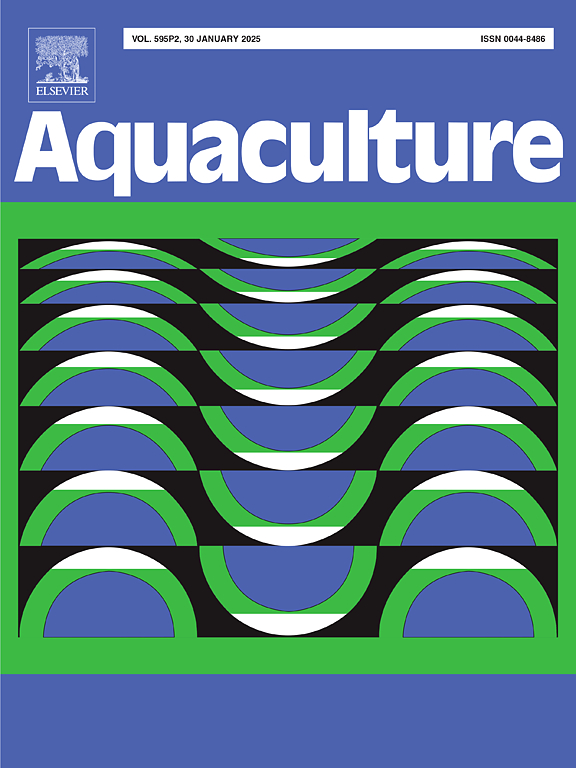缺氧条件下黄颡鱼体内 ATF6 和 IRE1-XBP1 信号介导的 ER 应激的新发现
IF 3.9
1区 农林科学
Q1 FISHERIES
引用次数: 0
摘要
在水产养殖过程中,鱼类经常面临缺氧这一主要应激源。然而,低氧诱导应激的机制仍不清楚。本研究旨在探讨黄颡鱼对低氧应激的生理和分子反应,并进一步阐明其应激反应机制。缺氧组每尾鱼(28.14 ± 0.75 g)被单独放置在一个 1 L 的透明塑料水箱中,然后转移到一个封闭的缺氧环境中,氧气和二氧化碳水平分别被调节到 2 % 和 0.5 %。结果表明,低氧应激会诱发黄颡鱼的应激反应,表现为血浆和肝脏中乳酸脱氢酶(LD)和皮质醇水平的显著变化,以及脑细胞凋亡和肝损伤的增加。此外,HPA 轴被激活,在缺氧暴露期间的应激调节中发挥着关键作用。在缺氧条件下,黄颡鱼肝脏中的内质网(ER)应激途径被激活,特别是活化转录因子6(ATF6)和肌醇需要酶1(IRE1)-X-盒结合蛋白1(XBP1)信号显著上调,而活化转录因子4(ATF4)途径则保持不活跃。ATF6、IRE1 和 XBP1 基因以及 ATF6 和 IRE1-XBP1 通路中的 ATF6、IRE1 和 XBP1 蛋白的表达水平显著升高。然而,蛋白激酶R样ER激酶(perk)、真核翻译起始因子2α(eif2α)和atf4关键基因以及PERK-ATF4通路中的PERK、EIF2α和ATF4蛋白的表达水平没有明显差异。研究首次得出结论,缺氧会通过 ATF6 和 IRE1-XBP1 信号通路显著激活黄颡鱼的 ER 应激,但不会通过 PERK-ATF4 通路。这些发现不仅为鱼类的应激反应机制提供了新的见解,而且为水产养殖管理提供了低氧诱导应激的准确分子靶标。本文章由计算机程序翻译,如有差异,请以英文原文为准。
New insights into ER stress mediated by ATF6 and IRE1-XBP1 signals in yellow catfish under hypoxia
In aquaculture, fish are often exposed to the major stressor of hypoxia. However, the mechanism of hypoxia-induced stress remains unclear. The present study aimed to investigate the physiological and molecular responses of yellow catfish (Pelteobagrus fulvidraco) to hypoxia stress and to further elucidate its stress response mechanisms. Each fish (28.14 ± 0.75 g) in the hypoxia group was individually placed in a 1 L transparent plastic tank and transferred to a closed hypoxia environment, where the oxygen and carbon dioxide levels were adjusted to 2 % and 0.5 %, respectively. The results showed that hypoxia stress induced a stress response in yellow catfish, characterized by significant changes in lactate dehydrogenase (LD) and cortisol levels in plasma and liver, as well as increased apoptosis of brain cells and liver damage. Additionally, the HPA axis was activated, playing a crucial role in stress regulation during hypoxia exposure. And under hypoxia conditions, endoplasmic reticulum (ER) stress pathways were activated in yellow catfish liver, specifically showing significant upregulation of the activating transcription factor 6 (ATF6) and inositol-requiring enzyme 1 (IRE1)-X-box binding protein 1 (XBP1) signals, while the activated transcription factor 4 (ATF4) pathway remained inactive. The expression levels of atf6, ire1 and xbp1 genes, as well as ATF6, IRE1 and XBP1 proteins in the ATF6 and IRE1-XBP1 pathways, were significantly elevated. However, there was no significant differences in the expression levels of protein kinase R-like ER kinase (perk), eukaryotic translation initiation factor 2α (eif2α) and atf4 key genes, as well as PERK, EIF2α and ATF4 proteins in the PERK-ATF4 pathway. It is concluded for the first time that hypoxia significantly activates ER stress through the ATF6 and IRE1-XBP1 signaling pathways, but not the PERK-ATF4 pathway in yellow catfish. These findings not only provide new insights into the stress response mechanisms of fish but also offer the accurate molecular target of hypoxia-induced stress for aquaculture management.
求助全文
通过发布文献求助,成功后即可免费获取论文全文。
去求助
来源期刊

Aquaculture
农林科学-海洋与淡水生物学
CiteScore
8.60
自引率
17.80%
发文量
1246
审稿时长
56 days
期刊介绍:
Aquaculture is an international journal for the exploration, improvement and management of all freshwater and marine food resources. It publishes novel and innovative research of world-wide interest on farming of aquatic organisms, which includes finfish, mollusks, crustaceans and aquatic plants for human consumption. Research on ornamentals is not a focus of the Journal. Aquaculture only publishes papers with a clear relevance to improving aquaculture practices or a potential application.
 求助内容:
求助内容: 应助结果提醒方式:
应助结果提醒方式:


